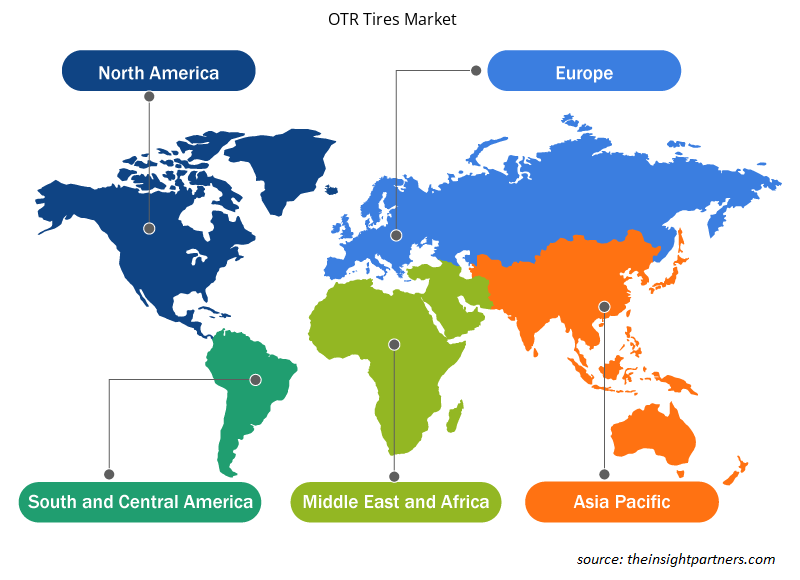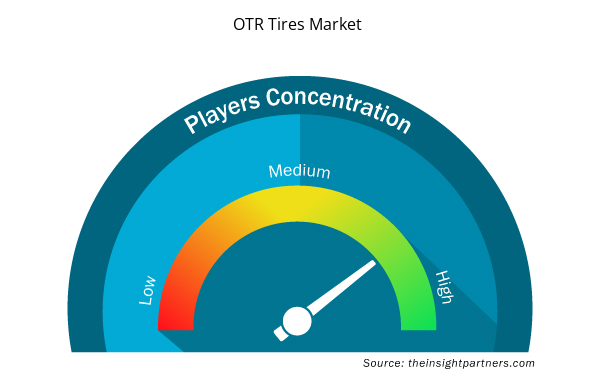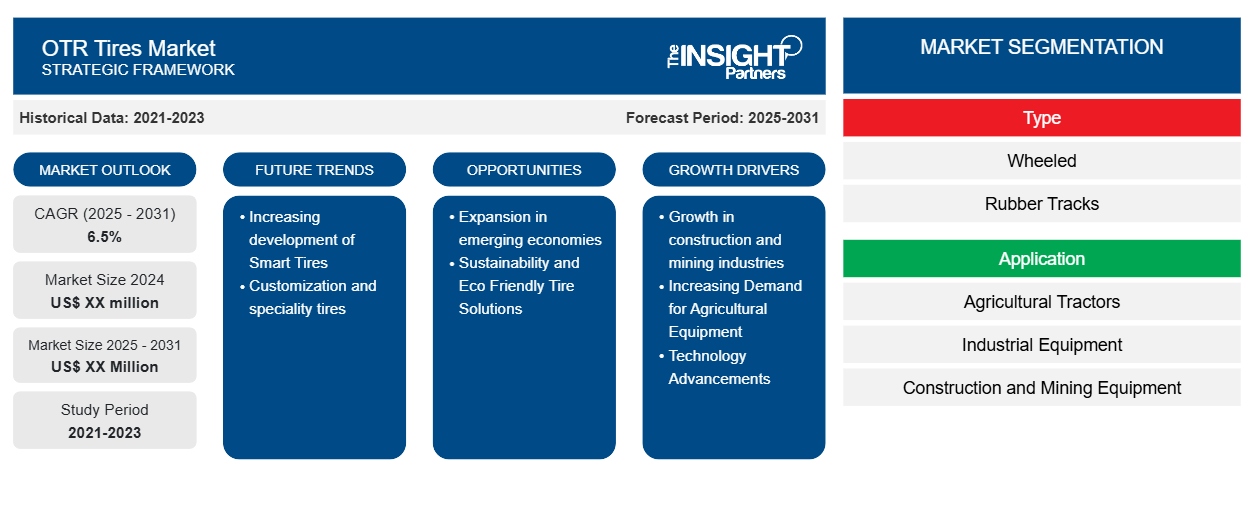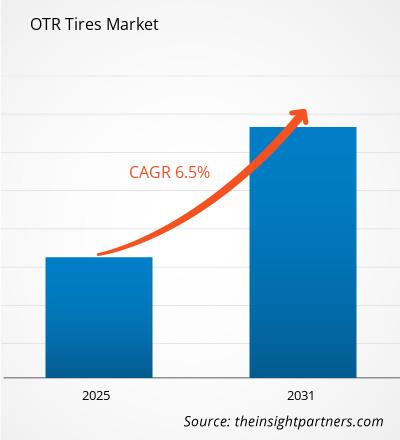Se espera que el mercado de neumáticos OTR registre una CAGR del 6,5 % entre 2023 y 2031, con un tamaño de mercado que se expandirá de US$ XX millones en 2023 a US$ XX millones en 2031.
El informe está segmentado por tipo (ruedas, orugas de caucho); aplicación (tractores agrícolas, equipos industriales, equipos de construcción y minería, otros). El análisis global se desglosa aún más a nivel regional y por países principales. El informe ofrece el valor en USD para el análisis y los segmentos anteriores.
Propósito del Informe
El informe OTR Tires Market de The Insight Partners tiene como objetivo describir el panorama actual y el crecimiento futuro, los principales factores impulsores, los desafíos y las oportunidades. Esto proporcionará información a diversas partes interesadas del negocio, como:
- Proveedores/fabricantes de tecnología: Para comprender la dinámica cambiante del mercado y conocer las oportunidades potenciales de crecimiento, lo que les permitirá tomar decisiones estratégicas informadas.
- Inversionistas: Realizar un análisis exhaustivo de tendencias sobre la tasa de crecimiento del mercado, las proyecciones financieras del mercado y las oportunidades que existen en toda la cadena de valor.
- Órganos reguladores: Regular las políticas y vigilar las actividades del mercado con el objetivo de minimizar los abusos, preservar la confianza de los inversores y defender la integridad y la estabilidad del mercado.
Segmentación del mercado de neumáticos OTR
Tipo
- Con ruedas
- Pistas de goma
Solicitud
- Tractores agrícolas
- Equipos industriales
- Maquinaria de construcción y minería
- Otros
Personalice este informe según sus necesidades
Obtendrá personalización en cualquier informe, sin cargo, incluidas partes de este informe o análisis a nivel de país, paquete de datos de Excel, así como también grandes ofertas y descuentos para empresas emergentes y universidades.
- Obtenga las principales tendencias clave del mercado de este informe.Esta muestra GRATUITA incluirá análisis de datos, desde tendencias del mercado hasta estimaciones y pronósticos.
Factores impulsores del crecimiento del mercado de neumáticos OTR
- Crecimiento en las industrias de la construcción y la minería: El principal motor de crecimiento del mercado de neumáticos OTR es el crecimiento en las industrias de la construcción y la minería. Con el aumento de los proyectos de desarrollo de infraestructura y las actividades mineras en todo el mundo, la maquinaria pesada y los equipos para dichas operaciones dependen cada vez más de los neumáticos OTR.
- Demanda creciente de equipos agrícolas: esta es otra fuerza impulsora importante detrás del mercado de neumáticos OTR. Con las técnicas modernizadas en la agricultura y la necesidad de una mayor eficiencia en la agricultura, existe un aumento en la demanda de vehículos y equipos agrícolas que dependen del funcionamiento con neumáticos OTR.
- Avances tecnológicos: la mejora de la ciencia de los materiales mediante la aplicación de un compuesto de alta resistencia, así como un mejor diseño de la banda de rodadura, ha sido la característica más mejorada en la fabricación de neumáticos, con mayor durabilidad, mayor tracción y mucha más resistencia al calor. El tiempo garantiza una mayor vida útil de los neumáticos acompañada de un mejor rendimiento, ya que sustituye el reemplazo de un mayor número de veces. El crecimiento del mercado se está logrando debido a las demandas en aplicaciones exigentes, porque la inversión en I+D para mejorar el rendimiento de los neumáticos de los fabricantes está ahí.
- Mayor enfoque en la eficiencia de la flota: las empresas que operan en industrias pesadas muestran un gran interés por la eficiencia de las flotas junto con la reducción de costos a través de la eficiencia operativa. Los neumáticos OTR inciden directamente en los objetivos de rendimiento del vehículo, eficiencia de combustible y costos de mantenimiento. La inversión en neumáticos OTR de buena calidad da como resultado menos tiempo de inactividad debido a fallas, mejor consumo de combustible debido a la reducción de la resistencia a la rodadura y costos generales de mantenimiento más bajos. Debido a esta necesidad de optimizar las operaciones en mercados competitivos, la demanda de neumáticos OTR premium para mejorar la productividad y la rentabilidad está creciendo.OTR tires directly impact the objectives of vehicle performance, fuel efficiency, and maintenance costs. Investment in good-quality OTR tires results in less time down due to failures, better fuel consumption due to the reduction of rolling resistance, and overall lower maintenance costs. Due to this need to optimize operations in competitive markets, the demand for premium OTR tires to enhance productivity and profitability is growing.
Tendencias futuras del mercado de neumáticos OTR Tires Market Future Trends
- Creciente desarrollo de neumáticos inteligentes: actualmente, el mercado de neumáticos OTR está avanzando hacia la digitalización. Con el uso de tecnologías de neumáticos inteligentes, los sensores pueden proporcionar detalles como el monitoreo de parámetros en tiempo real como la presión, la temperatura o el desgaste de la banda de rodadura. Estos datos pueden luego enviarse a los sistemas de gestión de flotas, lo que permite un mantenimiento proactivo y maximiza la eficiencia operativa. A medida que las empresas adoptan tecnologías inteligentes para un mejor rendimiento de las flotas, la demanda de neumáticos OTR inteligentes aumentará, lo que impulsará la competencia y la innovación en el mercado.OTR tire market is moving towards towards digitalization. With the use of smart tire technologies, sensors can provide details such as monitoring real-time parameters such as pressure, temperature, or tread wear. This data can then be forwarded to fleet management systems, therefore allowing proactive maintenance and maximizing operational efficiency. As the companies embrace smart technologies for better performance of fleets, the demand for smart OTR tires is bound to rise, hence fueling competition and innovation in the market.
- Personalización y neumáticos especiales: La tendencia a la personalización en el mercado de neumáticos OTR es general debido a la necesidad de que los usuarios finales tengan un diseño de neumático específico para una aplicación o un terreno en particular. Los fabricantes reaccionan con una línea diversificada de diseños, tamaños y patrones de banda de rodadura en continuo crecimiento que responde a diversos requisitos de las industrias de la agricultura, la construcción o la minería, por ejemplo. Esta tendencia hacia la especialización permite a una empresa diferenciar productos al mismo tiempo que atiende a nichos de mercado. Dicha especialización conduce al crecimiento de los neumáticos OTR y fomenta una mayor satisfacción del cliente a través de soluciones efectivas.
Oportunidades de mercado para neumáticos OTR
- Expansión en las economías emergentes: La rápida industrialización y urbanización que se está produciendo en las economías emergentes ofrece enormes oportunidades para el mercado de neumáticos OTR. Los países de la región de Asia-Pacífico, América Latina y África están realizando grandes inversiones en proyectos de infraestructura y minería, lo que refleja un aumento de la demanda de OTR. Con el surgimiento de estos mercados, existen oportunidades para que los fabricantes aumenten su red de distribución y se asocien con empresas locales para captar participación de mercado. Los fabricantes pueden explotar el potencial de crecimiento de los mercados emergentes diseñando el producto para satisfacer los requisitos de esos mercados.
- Sostenibilidad y soluciones ecológicas para neumáticos: la sostenibilidad surge como un tema importante, que ha ido en aumento en las industrias automotriz e industrial, y crea una oportunidad para innovar en el mercado de neumáticos OTR. Esto puede tomar la forma de uso de materiales sostenibles combinados con diseños basados en la práctica que involucren caucho renovable y baja resistencia a la rodadura, lo que mejora la eficiencia del combustible al tiempo que crea programas de reciclaje para neumáticos que ayudan a la conservación del medio ambiente. Las empresas pueden atraer clientes "conscientes del medio ambiente" al mercado de neumáticos OTR y, al mismo tiempo, diferenciarse en un mercado muy competitivo mediante la alineación con los objetivos globales de sostenibilidad.
Perspectivas regionales del mercado de neumáticos OTR
Los analistas de Insight Partners explicaron en detalle las tendencias y los factores regionales que influyen en el mercado de neumáticos OTR durante el período de pronóstico. Esta sección también analiza los segmentos y la geografía del mercado de neumáticos OTR en América del Norte, Europa, Asia Pacífico, Oriente Medio y África, y América del Sur y Central.

- Obtenga datos regionales específicos para el mercado de neumáticos OTR
Alcance del informe de mercado de neumáticos OTR
| Atributo del informe | Detalles |
|---|---|
| Tamaño del mercado en 2023 | XX millones de dólares estadounidenses |
| Tamaño del mercado en 2031 | US$ XX millones |
| CAGR global (2023 - 2031) | 6,5% |
| Datos históricos | 2021-2022 |
| Período de pronóstico | 2024-2031 |
| Segmentos cubiertos | Por tipo
|
| Regiones y países cubiertos | América del norte
|
| Líderes del mercado y perfiles de empresas clave |
|
Densidad de actores del mercado de neumáticos OTR: comprensión de su impacto en la dinámica empresarial
El mercado de neumáticos OTR está creciendo rápidamente, impulsado por la creciente demanda de los usuarios finales debido a factores como la evolución de las preferencias de los consumidores, los avances tecnológicos y una mayor conciencia de los beneficios del producto. A medida que aumenta la demanda, las empresas amplían sus ofertas, innovan para satisfacer las necesidades de los consumidores y aprovechan las tendencias emergentes, lo que impulsa aún más el crecimiento del mercado.
La densidad de actores del mercado se refiere a la distribución de las empresas o firmas que operan dentro de un mercado o industria en particular. Indica cuántos competidores (actores del mercado) están presentes en un espacio de mercado determinado en relación con su tamaño o valor total de mercado.
Las principales empresas que operan en el mercado de neumáticos OTR son:
- Corporación Bridgestone
- CEAT Limitada.
- Continental AG
- Neumático Hankook
- Michelin SCA
Descargo de responsabilidad : Las empresas enumeradas anteriormente no están clasificadas en ningún orden particular.

- Obtenga una descripción general de los principales actores clave del mercado de neumáticos OTR
Puntos de venta clave
- Cobertura integral: el informe cubre de manera integral el análisis de productos, servicios, tipos y usuarios finales del mercado de neumáticos OTR, proporcionando un panorama holístico.
- Análisis de expertos: el informe se compila sobre la base de un profundo conocimiento de expertos y analistas de la industria.
- Información actualizada: El informe asegura relevancia comercial debido a su cobertura de información reciente y tendencias de datos.
- Opciones de personalización: este informe se puede personalizar para satisfacer los requisitos específicos del cliente y adaptarse adecuadamente a las estrategias comerciales.
Por lo tanto, el informe de investigación sobre el mercado de neumáticos OTR puede ayudar a abrir el camino para descifrar y comprender el escenario de la industria y las perspectivas de crecimiento. Si bien puede haber algunas preocupaciones válidas, los beneficios generales de este informe tienden a superar las desventajas.
- Análisis histórico (2 años), año base, pronóstico (7 años) con CAGR
- Análisis PEST y FODA
- Tamaño del mercado Valor/volumen: global, regional, nacional
- Industria y panorama competitivo
- Conjunto de datos de Excel



Report Coverage
Revenue forecast, Company Analysis, Industry landscape, Growth factors, and Trends

Segment Covered
This text is related
to segments covered.

Regional Scope
North America, Europe, Asia Pacific, Middle East & Africa, South & Central America

Country Scope
This text is related
to country scope.
Preguntas frecuentes
Some of the customization options available based on the request are an additional 3-5 company profiles and country-specific analysis of 3-5 countries of your choice. Customizations are to be requested/discussed before making final order confirmation, as our team would review the same and check the feasibility.
The report can be delivered in PDF/PPT format; we can also share excel dataset based on the request.
The leading players operating in the OTR Tires Market include Bridgestone Corporation, CEAT Ltd, Continental AG, Hankook Tire, Michelin SCA, Nokian Heavy Tyres Ltd, Pirelli Prometeon Tyre Group, Nokian Tyres plc, The Carlstar Group, LLC.
The OTR Tires Market is estimated to witness a CAGR of 6.5% from 2023 to 2031
Safety and Performance is the key future trend of the OTR Tires Market
The major factors driving the OTR Tires Market are:Growth in construction and mining industries#Increasing Demand for Agricultural Equipment
Trends and growth analysis reports related to Automotive and Transportation : READ MORE..
1. Bridgestone Corporation
2. CEAT Ltd.
3. Continental AG
4. Hankook Tire
5. Michelin SCA
6. Nokian Heavy Tyres Ltd
7. Pirelli (Prometeon Tyre Group)
8. TBC Corporation (Sumitomo)
9. The Goodyear Tire and Rubber Company
10. Yokohama Rubber Company
The Insight Partners performs research in 4 major stages: Data Collection & Secondary Research, Primary Research, Data Analysis and Data Triangulation & Final Review.
- Data Collection and Secondary Research:
As a market research and consulting firm operating from a decade, we have published and advised several client across the globe. First step for any study will start with an assessment of currently available data and insights from existing reports. Further, historical and current market information is collected from Investor Presentations, Annual Reports, SEC Filings, etc., and other information related to company’s performance and market positioning are gathered from Paid Databases (Factiva, Hoovers, and Reuters) and various other publications available in public domain.
Several associations trade associates, technical forums, institutes, societies and organization are accessed to gain technical as well as market related insights through their publications such as research papers, blogs and press releases related to the studies are referred to get cues about the market. Further, white papers, journals, magazines, and other news articles published in last 3 years are scrutinized and analyzed to understand the current market trends.
- Primary Research:
The primarily interview analysis comprise of data obtained from industry participants interview and answers to survey questions gathered by in-house primary team.
For primary research, interviews are conducted with industry experts/CEOs/Marketing Managers/VPs/Subject Matter Experts from both demand and supply side to get a 360-degree view of the market. The primary team conducts several interviews based on the complexity of the markets to understand the various market trends and dynamics which makes research more credible and precise.
A typical research interview fulfils the following functions:
- Provides first-hand information on the market size, market trends, growth trends, competitive landscape, and outlook
- Validates and strengthens in-house secondary research findings
- Develops the analysis team’s expertise and market understanding
Primary research involves email interactions and telephone interviews for each market, category, segment, and sub-segment across geographies. The participants who typically take part in such a process include, but are not limited to:
- Industry participants: VPs, business development managers, market intelligence managers and national sales managers
- Outside experts: Valuation experts, research analysts and key opinion leaders specializing in the electronics and semiconductor industry.
Below is the breakup of our primary respondents by company, designation, and region:

Once we receive the confirmation from primary research sources or primary respondents, we finalize the base year market estimation and forecast the data as per the macroeconomic and microeconomic factors assessed during data collection.
- Data Analysis:
Once data is validated through both secondary as well as primary respondents, we finalize the market estimations by hypothesis formulation and factor analysis at regional and country level.
- Macro-Economic Factor Analysis:
We analyse macroeconomic indicators such the gross domestic product (GDP), increase in the demand for goods and services across industries, technological advancement, regional economic growth, governmental policies, the influence of COVID-19, PEST analysis, and other aspects. This analysis aids in setting benchmarks for various nations/regions and approximating market splits. Additionally, the general trend of the aforementioned components aid in determining the market's development possibilities.
- Country Level Data:
Various factors that are especially aligned to the country are taken into account to determine the market size for a certain area and country, including the presence of vendors, such as headquarters and offices, the country's GDP, demand patterns, and industry growth. To comprehend the market dynamics for the nation, a number of growth variables, inhibitors, application areas, and current market trends are researched. The aforementioned elements aid in determining the country's overall market's growth potential.
- Company Profile:
The “Table of Contents” is formulated by listing and analyzing more than 25 - 30 companies operating in the market ecosystem across geographies. However, we profile only 10 companies as a standard practice in our syndicate reports. These 10 companies comprise leading, emerging, and regional players. Nonetheless, our analysis is not restricted to the 10 listed companies, we also analyze other companies present in the market to develop a holistic view and understand the prevailing trends. The “Company Profiles” section in the report covers key facts, business description, products & services, financial information, SWOT analysis, and key developments. The financial information presented is extracted from the annual reports and official documents of the publicly listed companies. Upon collecting the information for the sections of respective companies, we verify them via various primary sources and then compile the data in respective company profiles. The company level information helps us in deriving the base number as well as in forecasting the market size.
- Developing Base Number:
Aggregation of sales statistics (2020-2022) and macro-economic factor, and other secondary and primary research insights are utilized to arrive at base number and related market shares for 2022. The data gaps are identified in this step and relevant market data is analyzed, collected from paid primary interviews or databases. On finalizing the base year market size, forecasts are developed on the basis of macro-economic, industry and market growth factors and company level analysis.
- Data Triangulation and Final Review:
The market findings and base year market size calculations are validated from supply as well as demand side. Demand side validations are based on macro-economic factor analysis and benchmarks for respective regions and countries. In case of supply side validations, revenues of major companies are estimated (in case not available) based on industry benchmark, approximate number of employees, product portfolio, and primary interviews revenues are gathered. Further revenue from target product/service segment is assessed to avoid overshooting of market statistics. In case of heavy deviations between supply and demand side values, all thes steps are repeated to achieve synchronization.
We follow an iterative model, wherein we share our research findings with Subject Matter Experts (SME’s) and Key Opinion Leaders (KOLs) until consensus view of the market is not formulated – this model negates any drastic deviation in the opinions of experts. Only validated and universally acceptable research findings are quoted in our reports.
We have important check points that we use to validate our research findings – which we call – data triangulation, where we validate the information, we generate from secondary sources with primary interviews and then we re-validate with our internal data bases and Subject matter experts. This comprehensive model enables us to deliver high quality, reliable data in shortest possible time.


 Obtenga una muestra gratuita de este informe
Obtenga una muestra gratuita de este informe